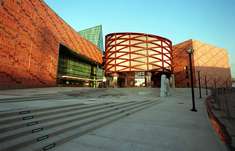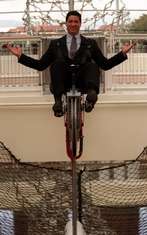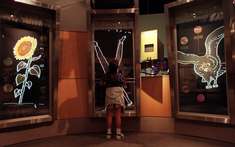|
|
|
 effrey
N. Rudolph, his expression as somber as his two-button gray worsted suit,
pedaled a bicycle out along effrey
N. Rudolph, his expression as somber as his two-button gray worsted suit,
pedaled a bicycle out along

Exterior view of the new $130-million
California Science Center in Exposition Park, which is scheduled to open
February 8, 1998.
WALLY SKALIJ / Los Angeles Times |
a high wire stretched 43 feet above the floor of the new $130-million
California Science Center in Exposition Park.
At midpoint in the void, Rudolph, the center's
42-year-old executive director, gingerly released the handlebars, extended
his arms, and grinned gleefully.
The principles of gravity, which under other
circumstances would hurl him to the floor so far below, had been harnessed
through a clever arrangement of counterweights to keep him balanced safely
aloft, no matter how much he leaned to the left or right. Gaining confidence,
he flapped his arms as if they were wings.
"Ahhhh, the inner child comes out,"
exhibit engineer Rosalie Kessling, who was monitoring Rudolph's test ride,
said approvingly.
That is just the reaction the 290 curators,
designers, consultants and administrative staff of the region's newest
public museum have been working for a decade to achieve. If the public
agrees when it opens next Saturday, the science center will put Southern
California in touch with its inner child in a dozen different ways through
vividly conceived science lessons housed in a landmark new building that
offers dramatic views of the Los Angeles cityscape.
Indeed, Rudolph's trust in the safe workings
of the bicycle exhibit is one small token of his conviction that the 245,000
square-foot center and its seven-story IMAX theater -- the keystone of
a $300-million renovation of Exposition Park and its facilities -- can
restore science and technology to a prominent place in the public

Executive director Jeffrey
N. Rudolph, 42, pedals a bicycle out along a high wire stretched 43-feet
above the floor of the new $130-million California Science Center in Exposition
Park .
WALLY SKALIJ / Los Angeles Times |
heart of Southern California.
Situated between the Los Angeles Memorial
Coliseum and the park's expansive rose gardens, the science center is an
imaginative lesson plan distilled in concrete, stainless steel and terra
cotta tile. It is a place where fundamental concepts take mind-teasing
physical form. Basic questions and observations of the natural world are
literally underfoot -- inscribed on the stone slabs that pave the entranceway.One
inscription admonishes: "The universe is full of magical things patiently
waiting for our wits to grow sharper."
From a five-story kinetic sculpture, to a 50-foot robot that lectures
on human biology with a wave of its 2-ton arm, curators have infused the
center with a remarkable theatricality. There is a walk-in microscope,
a virtual reality space docking simulator, and discovery rooms decorated
with Toontown flair.
"We want people to say: Wow," Rudolph
said.
"If we accomplish that -- if people
feel empowered and knowledgeable -- then we will have made a meaningful
impact."
Entertaining and Educating
The high-wire bicycle is an apt metaphor for the center's own balancing
act, as it rides the line between entertainment and education -- competing
with traditional amusement parks for visitors without sacrificing the integrity
of its teaching mission.
"There are pressures to make decisions
more on marketing than on educational mission," Rudolph said. "We
have to attract people. We think about marketing. We think about the draw.
But we also try to maintain an educational experience."
Deputy Director Ann Muscat said the center's
challenge is to keep its institutional equilibrium centered on the line
between play and learning, while competing fiercely with theme parks, computer
games, cable television and other commercial "edutainment" venues
for the attention of millions of students, parents and teachers.
It is a taste of things to come for the 160-acre
urban oasis of Exposition Park.
Even as they cut the ribbon to open the center,
officials are preparing to break ground this fall for a $30-million science
elementary school on the center grounds. On the drawing boards are a $90-million
aquarium and a $65-million hall devoted to astronomy and space exploration.
The center's aerospace hall is scheduled to undergo six months of renovations
starting next month.
Under a master plan recently given an urban
design award by the American Institute of Architects, officials also hope
to double the amount of open parkland, turning asphalt lots back into green
space and adding tree-shaded promenades. Four playgrounds are under construction.
Working in partnership with the Los Angeles
Unified School District and USC's graduate school of education, the growing
center

A visitor views an exhibit
in the "World Of Life" hall, which explains how all living things
depend on same biology.
WALLY SKALIJ / Los Angeles Times |
complex is designed to play a crucial role in shaping science education
throughout the region. This comes at a time when state educators are struggling
for ways to better teach science in public schools and experts across the
country are bemoaning the public's scientific ignorance.
The National Science Foundation recently
reported that while more than two-thirds of Americans believes science
is important to their lives, only one in nine believes he or she is well
informed about it and only one in four demonstrates any science literacy.
"People increasingly think science is
a black box," said Loren Behr, director of programs at the California
Academy of Sciences. "In our society, we tend to have a lot of confidence
in science to solve our problems but we have absolutely no idea about how
scientists arrive at the solutions."
The ignorance spans all fields of scientific
endeavor.
More than half of American adults are unaware
that the last dinosaur died before the first human arose or that electrons
are smaller than atoms. Three-quarters do not know that antibiotics kill
bacteria but not viruses. Almost half of American adults do not know that
the Earth orbits the sun, the National Science Foundation survey reported.
Children are often as hard-pressed to find
the answers to such science questions at school as they are at home. In
many schools, inadequately trained teachers are often over their heads
with matters of science and technology.
In fact, the privately funded National Commission
on Teaching and America's Future determined recently that in schools with
the highest minority enrollments, students had less than a 50% chance of
getting a science or mathematics teacher who held a license or a degree
in the field.
Against this backdrop, Rudolph and his colleagues
have created a science center that several museum experts already hail
as one of the largest and most sophisticated in the country. It replaces
Exposition Park's old Museum of Science and Industry, which was closed
in 1990. Officials readily acknowledge that the old museum was "uninspiring"
and that its exhibits were an "ill-conceived hodgepodge."
In the new science center, "there are
gee-whizzes wherever you look," said USC Dean of Education Gilbert
Hentschke, who has toured the facility three times in recent weeks.
Fred Shair at the Jet Propulsion Laboratory's
office of education, said simply: "I fell in love with their vision."
The California Science Center, however, is
meant to be more than a haven for children on a rainy afternoon.
Center officials and area educators have
made the new facilitythe focus of an ambitious effort to develop new techniques
for teaching science in the public schools. That puts the California Science
Center at the forefront of a trend in education that has seen the creation
of more than 300 science museums across the country in recent years, said
Bonnie Van Dorn, executive director of the Assn. of Science and Technology
Centers.
"One of the things that impresses me
about the reinvention of the science center is its commitment to top-level
collaborations with schools," Van Dorn said.
Only Buffalo and Phoenix have made a public
school a formal part of a science center. No other center, however, has
such ambitious plans to serve as a laboratory for new teaching techniques
or has reached out so extensively to disadvantaged neighborhoods, experts
said. Science centers traditionally draw the bulk of their support from
affluent suburbs.
"Nationally, we are seeing a growing
trend toward relationships between science centers and the schools and
universities that train teachers. But there are not very many science centers
that have taken on [the] kind of bold, formal collaboration" being
undertaken in Los Angeles, Van Dorn said.
"It takes a lot of work and energy,"
she said. "It makes this place stand out."
A Populist Expression of Aspirations for L.A.
The California Science Center is the second major museum to open in
Los Angeles in recent months. Comparisons to the new Getty Center are perhaps
inevitable, in part because the institutions are exemplars of what British
essayist C.P. Snow called the two cultures of art and science.
The $1-billion Getty, on 110 acres high above
the city it is designed to enrich, is a triumph of private taste, privately
and lavishly endowed. Through its collections, it embodies a culture's
relationship to its past, harnessing science to restore and preserve the
arts.
In contrast, the new state science center
is a Populist expression of a community's aspirations for its future, located
in the heart of its urban neighborhoods.
A collection of concepts, rather than artifacts,
it owes its existence to a coalition of public officials, private citizens
and corporate philanthropists. Throughout the center, designers have used
art to reflect the spirit of science.
In its essence, the new science center is
the expression of an impulse as "basic as wanting people to understand
our world so they can make informed choices," said Gayle Wilson, wife
of Gov. Pete Wilson, who toured the center recently as curators were putting
the finishing touches on exhibits.
"They have done a fantastic job,"
she said. "It sparks curiosity and will encourage children to explore
and discover. This museum will encourage them to learn while having fun."
From the moment visitors approach the science
center, its designers -- led by the Los Angeles architectural partnership
of Zimmer Gunsel Frasca and Oakland-based West Office Exhibition Design
-- have sought to cultivate a contemplative yet playful frame of mind.
Visitors will enter through the California
Gate -- a pair of granite plinths 13 feet high that in the empty space
between them create a map of the state -- and stroll past a 113-foot-long,
terraced waterfall into an open-air pavilion.
There, one may sit on the "DNA bench,"
shaped like a cross-section of the molecule of life and wreathed in mist
from a fog machine at its center, or pause to read quotations from poets
like Maya Angelou and Lao-tze etched in the stone.
Overhead, a constellation of 1,500 gold-
and palladium-plated spheres, meant to evoke the swirling cosmos, reflects
the magenta-colored sunlight filtering through an immense skylight of special
dichoric glass.
The setting is intended to take one from
the microscopic to the telescopic in a glance, Muscat said.
To the right, visitors can enter a new, 485-seat
IMAX theater, with a screen seven stories high and 90 feet wide that can
handle both 3-D IMAX and conventional large-format IMAX films. The old
IMAX theater will be torn down.
Through the center's main entrance, a 10,000-square-foot
courtyard feeds into a large museum store, several restaurants, and two
major permanent exhibit halls.
Animating the main lobby is a motorized,
six-sided sculpture by New York engineer Chuck Hoberman of an expanding
hyperbolic paraboloid, a so-called minimal surface, like that formed in
a soap bubble. The 5,000-pound sculpture, made of more than 2,500 aluminum
links, expands from a compact cluster 15 feet across to a double curve
50 feet high.
"A piece like this is something between
a sculpture and an event," Hoberman said. "As an event, there
is an element of choreography. The idea is that it is variable, to create
a variety of experiences.
"It invites the next step of "Why?'
" he said.
To begin to answer that, the center's $8-million
"Creative World' area examines the technology of the everyday world,
from electronics to transportation, through 22,000 square feet of exhibits
including digital jam sessions, virtual volleyball and a wind tunnel.
"The exhibit images are both positive
and negative, showing what we have accomplished but also the problems that
we have dealt with, to understand the consequences of technology"
Muscat said.
The $7-million "World of Life"
area probes the biological processes that all living things have in common,
by showing how plants, people and other animals perform critical life processes.
Certainly, all the exhibits are as elaborately
produced as any theme park ride, scripted as carefully as a television
pilot and tested before focus groups as thoroughly as a national advertising
campaign.
The centerpiece of the "BodyWorks"
exhibit in the "World of Life" hall, for example, is a $1.5-million
50-foot, anatomically correct body simulator called Tess, which is part
of a multimedia presentation on how the human body maintains its biological
balance. It took 220 special effects experts, computer programmers, lighting
designers, animators, script writers and actors to create the exhibit.
"Tess seemed like an ideal mechanism
to communicate the idea of how the organs work together to keep your body
in balance," said curator David Combs. "It is an intensely theatrical,
highly produced piece that really takes advantage of technology to help
get people interested."
There also is an 8,000-square-foot hall for
traveling science exhibits, which will open with an exhibit called "Science
in Toyland" and will be followed later this year by "The Power
of Numbers," developed at the Franklin Museum of Science in Philadelphia.
Those who have watched the center take shape
say it is a dramatic improvement over the Museum of Science and Industry.
"They have taken some of the best things
of all of the other existing types of [science] facilities," said
David Ucko, president of the Kansas City Museum, which is undergoing its
own $234-million expansion project. "They have become much more science
focused, much more thematic, tying things together."
Museum visitors who ride the high-wire bicycle
will have the benefit of a safety net, but the center has decided, as a
matter of policy, to perform without the financial safety net of guaranteed
public funding.
Center officials expect more than 2 million
visitors a year -- at least 200,000 of them schoolchildren on field trips.
But, unlike many counterparts around the country, the California Science
Center will not charge admission. And only about a third of its $17-million
annual operating budget is covered by state funding.
Without admission revenues, the center must,
therefore, rely on a mixed bag of film and parking revenues, corporate
philanthropy, individual donations and concession sales.
To make ends meet, considerable space is
set aside for revenue-producing areas such as a retail gift shop called
the "Explorastore" and a conference center that can serve a sit-down
dinner for 500 or handle meetings of up to 700.
The IMAX theater, which center officials
expect to draw about 700,000 people a year, will charge $7.50 for 3-D films
and $6.50 for more conventional IMAX features.
From its inception, the Science Center has
operated on shoestring financing.
In all, the center has raised about $128
million from private and public sources. At every juncture, center officials
displayed a gift for making a virtue of necessity.
For example, the seed money for construction
-- $47 million in state money -- came from funds originally allocated to
make earthquake repairs to the old headquarters of the Museum of Science
and Industry, which once occupied the site.
The master plan first took shape under then-Gov.
George Deukmejian and then-Assemblywoman Maxine Waters. Gov. Wilson, state
Sen. Teresa Hughes and then-Assemblywoman Marguerite Archie-Hudson helped
secure funding.
The California Science Center Foundation,
currently headed by Board of Trustees President John Sussman, has raised
more than $33 million from the private sector.
A series of key grants from NASA, JPL and
the National Science Foundation helped underwrite the development of the
exhibits and jump-start the education programs.
The largest single corporate contributor
was Toyota, which donated $1.8 million to help underwrite transportation
exhibits.
"If you are familiar with science test
scores internationally, American high school students rank pretty damn
near the bottom," said James Olson, senior vice president of external
affairs for Toyota Motor Sales USA. "We thought it was a good place
to put our leverage."
 Search
the archives of the Los Angeles Times for similar stories. You will
not be charged to look for stories, only to retrieve one. Search
the archives of the Los Angeles Times for similar stories. You will
not be charged to look for stories, only to retrieve one.
Copyright Los Angeles Times
|
